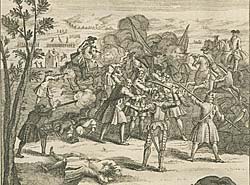| Disorder and Unrest |
Staffordshire is probably best known for two main periods of unrest and disorder in its history: the Civil War and the Chartist Riots in the Potteries. The county’s association with Jacobitism, support for the Stuarts against the Hanoverian succession in the early 18th century, is perhaps less well known.
The outbreak of the Civil War did not lead to immediate polarising of Royalists and Parliamentarians in the county. However opposition to the King gradually crystallised mainly in the Staffordshire Moorlands, while Royalist support tended to lie with the big Catholic families in the county. The war started to impact on the county from 1642 with the seizure of Stafford and Tamworth by the Royalists. 1643 saw the siege and capture of Lichfield Close by Parliamentary forces and its re-capture by the Royalists under Prince Rupert. 1643 also saw the only major Civil War battle in Staffordshire, the Battle of Hopton Heath. Further organised activity between the warring sides took place in the county from 1644 until 1646. When Charles II tried to regain the throne in 1651 he fled to Staffordshire after his defeat at the Battle of Worcester to be aided in his escape by the Pendrell, Whitgreave and Lane families.
Staffordshire was considered to be a county with Jacobite sympathies. Jacobite activity in the county in the early 18th century was demonstrated in widespread riots attacking Protestant meeting houses in 1715. However the march of the Young Pretender through the county in 1745 failed to arouse any substantial local support. By the mid 18th century, Jacobitism in Staffordshire was effectively dead.
It was not until 1842 that working class discontent found its expression in the Chartist riots in the Pottery towns. These took place in the context of North Staffordshire colliers’ strikes and the prevailing economic distress arising from these. The riots themselves broke out in August, 1842 and left a trail of devastation. They resulted in a special commission to try the rioters in which 56 men altogether were transported for their part in the riotous activities.
All of this was played out against the political development of the county and the impact of parliamentary reform. Examples of electoral corruption were not unique to Staffordshire any more than any other county. However a notable occasion was the election of 1832, when one of the candidates for Stafford Borough paraded into the town, preceded by a band with banknotes placed in their hatbands.
|
|

Archive Sources
Contemporary account of the Battle of Hopton Heath, the most significant battle in Staffordshire during the Civil War,
19 March 1643
Engraving of the Battle of Hopton Heath showing the attack on the Earl of Northampton, 18th century
The Parliamentarians’ Articles of Faith, 1648
Letter concerning preparations against the Young Pretender, 1745
Petition of the Mayor and Burgesses of the town of Stafford against a proposed Act of Parliament to disenfranchise the Borough, c1835
Address to Rev Robert Ellis Aitkens from the congregation of St John’s Chapel, Hanley, following the attack by the Chartist rioters on his house, August 1842.
Letter from Joseph Mayer to Francis Twemlow of Betley Court, describing the Chartist riots in Hanley and Stoke, 1842
Minute Book of the Fenton Commissioners explaining the loss of the previous book
|

